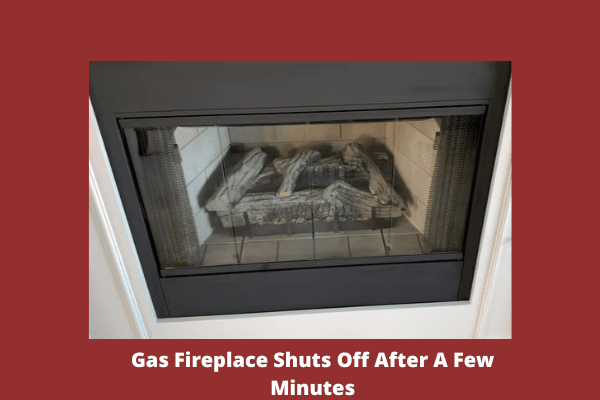If your gas fireplace shuts off after a few minutes, the main reasons behind it are faulty pilot light, malfunctioning thermocouple or thermopile, bad oxypilot, poor gas supply, lack of gas pressure, clogged burner ports, and cracked components.
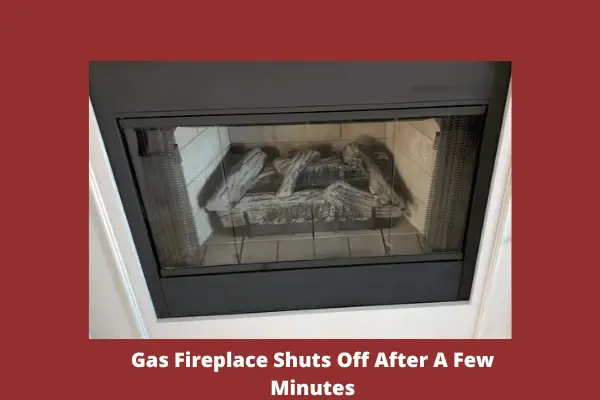
Keep reading this article to find out more about these issues in detail and learn how you can fix each of them.
You’ll also learn to check whether your fireplace is safe and get acquainted with some basic safety precautions when you’re cleaning your fireplace yourself. Let’s begin!
Table Of Contents
- Gas Fireplace Shuts Off After A Few Minutes [7 Easy Fixes]
- 1. Faulty Pilot Light
- How To Fix Gas Fireplace Goes Out But Pilot Stays On
- 2. Malfunctioning Thermocouple Or Thermopile
- 3. Bad Oxypliot
- 4. Poor Gas Supply
- 5. Lack Of Gas Pressure
- 6. Clogged Burner Ports
- 7. Cracked Components
- Other Reasons Why Your Gas Fireplace Won’t Stay Lit
- i). Faulty Gas Valve
- ii). Moisture In Gas Line
- iii). Dead Batteries
- iv). Tripped Circuit Breaker
- What Are The Safety Measures When Cleaning A Gas Fireplace?
- i). Turn Off The Gas Supply
- ii). Be Gentle When You Take Things Apart
- iii). Avoid Spray Cleaners
- How To Check Whether Your Fireplace Is Safe
- i). Inspect The Cleanliness Of The Components
- ii). Check The Quality Of Flame
- iii). Investigate The Chimney
- FAQs:
- Why is my gas fireplace going on and off?
- How to maintain your gas fireplace?
- How to tell if you have a weak thermocouple?
- When should you replace the gas fireplace logs?
- How long does a gas fireplace last?
- What should you do if the fireplace smells like gas?
- Is it safe to keep a gas fireplace running all the time?
- What does it cost to fix a gas fireplace?
- Conclusion
Gas Fireplace Shuts Off After A Few Minutes [7 Easy Fixes]
We’ll discuss the most common reasons why your gas fireplace goes out after a few minutes in this section.
Note: You can also read how to fix Heat N Glo Fireplace turns off by itself problem.
1. Faulty Pilot Light
The pilot light is an essential component of the gas fireplace that needs to be in top-notch condition to start and maintain a fire. You need to hold “pilot” on the control knob and dial it to the on position when you start your gas fireplace.
If you’re having difficulty or the gas fire goes out after 15 minutes or so, chances are you have a faulty pilot light.
There are usually two types of flame that come from the fireplace – the first one is the large one over the burner and the other one is the smaller one touching the thermocouple.
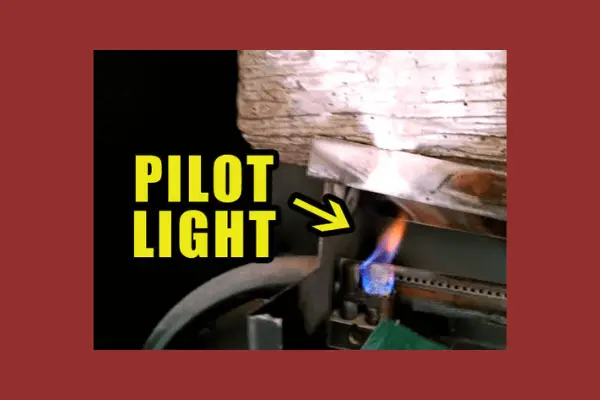
The main culprit behind a faulty pilot light is the build-up of dirt and debris in the pilot light assembly. The dust causes a lazy flame which is disturbed by the main burners.
The flame lifts from the thermocouple and that sends the wrong reading of the temperature to the thermocouple. It thinks that the temperature is too low and shuts off the gas fireplace altogether.
Solution:
If you suspect you have a faulty pilot light and that’s causing your gas fireplace to go out after a few minutes, the first thing you should do is clean it. Once you’re done with the cleaning, check if the problem goes away.
Remember that the flame coming from the pilot light should always be light blue in color with little bits of yellow in it.
If the flame is largely yellow, that means it’s not working properly. You can try cleaning again to solve the problem. If that doesn’t work, call in a professional who can help you.
How To Fix Gas Fireplace Goes Out But Pilot Stays On
While we’re discussing pilot lights, let’s address another common issue that many users face. And that problem is that the pilot light stays on even when the gas fireplace goes out.
It usually happens when there’s excess gas leading up to the pilot light. To solve this issue, shut the gas feed to the fireplace and wait for a few minutes. It’ll get rid of the excess gas and reset the pilot light.
2. Malfunctioning Thermocouple Or Thermopile
Most people don’t know the difference between a thermocouple and a thermopile. But if you know it, it can help you to diagnose the issue earlier and make it easier to solve your problem.
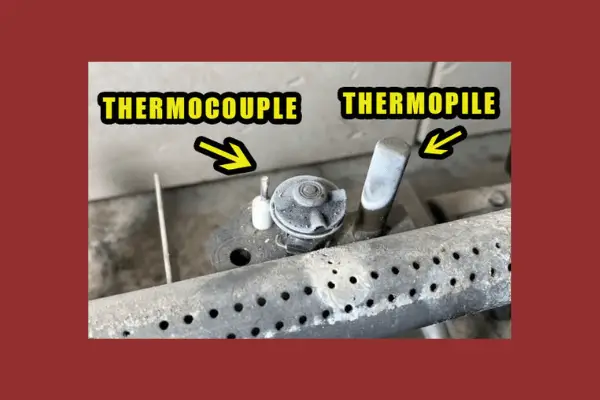
The thermocouple mainly acts as a sensor that detects whether there’s enough heat being generated in your fireplace. Think of it as a thermometer that consists of two wires joined at both ends. One end measures the temperature while the other remains fixed.
The thermopile makes sure the gas is supplied to the fireplace as it opens up the gas valve when you switch on the fireplace. Both these parts work together to provide gas to the fireplace.
If you have a multimeter, you can easily inspect if the thermopile and thermocouple in your fireplace are in working condition. If you have a multimeter, you can follow these steps to check them:
- Turn on your gas fireplace and let the pilot light run for a few minutes.
- Turn the fireplace off.
- Find the contacts that are marked as TH/TP and TP on the thermopile.
- Connect the leads of the multimeter to these contacts.
A reading of 300 millivolts or above in the multimeter means that your thermopile is in perfect working condition. But if it’s less than 300, it’s likely that you have a faulty thermopile.
You can inspect the thermocouple as well with a multimeter by following the process. You just need to it on the thermocouple sensor instead of the thermopile sensor.
The normal reading for a good thermocouple is 25 millivolts or more. If your reading is less than that, your thermocouple has gone bad.
Solution:
If you’ve successfully diagnosed that’s it either a bad thermopile or thermocouple that causes your gas fireplace to go out, the first thing you should do is clean it.
Carbon deposits can build up in both these parts with time and that keeps them from functioning properly. Give them a good cleaning with a stainless steel brush and fine-grit sandpaper.
After you’re done cleaning them and you’re happy with how they look, you need to run the tests again. If the reading comes to normal and your gas fireplace stays on, your problem is solved.
But if they’re still not giving acceptable readings, you need to replace them. You don’t have to panic about replacing them as these parts are quite inexpensive and you can install them yourself.
3. Bad Oxypliot
Most of the gas fireplaces we commonly see have a safety feature built into them. This safety feature automatically shuts off the fireplace when a sensor detects that the oxygen in the room is depleted to a dangerous extent.
The sensor that does this job and measures the level of oxygen in the air is called an oxypliot. It’s a crucial component as it prevents the room from having a harmful level of carbon monoxide. Excessive carbon monoxide in the air can even cause death.
So, whenever the oxypilot senses that there’s insufficient oxygen in the room, it shuts off the fireplace to prevent you from carbon monoxide poisoning. But when this sensor doesn’t work correctly, it can get a faulty reading and cause the heater to shut off even when there’s enough oxygen in the room.
If your gas fire goes out after 20 minutes or so, it’s likely you have a faulty oxypilot. The main reasons behind the oxypliot not working correctly are either it’s clogged up or the sensor itself has gone bad with time.
Solution:
First, start by ensuring that there’s enough oxygen in your room. If your gas fireplace shuts off after 30 minutes for no reason, maybe you don’t have any air source coming in.
The sensor is working correctly and you actually have a low level of oxygen in your room. You can remedy it by opening a window to let in air. If you confirm that the oxygen level in your room is fine, the next thing you need to do is to clean the oxypilot.
It’s often the build-up of dirt that makes it clogged and keeps it from functioning properly. Cleaning it should solve your problem. If the fireplace still keeps shutting off, replace the oxypilot.
4. Poor Gas Supply
If you’re still wondering why does my gas fireplace go out after a few minutes, it could be due to an insufficient supply of gas. When you keep burning the fireplace, the gas has a higher chance of burning out quickly.
If you were already running low on gas, it can become empty, and shut off the fireplace. Moreover, many people make the mistake of supplying their gas fireplaces with the wrong type of gas.
Gas fireplaces usually run on propane or natural gas. If you feed natural gas to a propane fireplace and vice-versa, it can cause issues with your fireplace and shut it down.
Solution:
Make sure that you’re supplying the correct type of gas first by checking the requirements on your owner’s manual or the markings on the control valve.
LPG refers to propane gas whereas NG refers to natural gas. Also, make sure that you have a decent supply of gas.
The next thing you need to do is to adjust the gas flow in your fireplace with the control knob. Follow these steps to do it:
- Locate the knob that controls how much gas your fireplace uses.
- It’s commonly found below the ceramic blog, is black in color, and has the word “pilot” on it.
- Turn the control knob to the “pilot” setting to start lighting the gas.
- Hold it for a few seconds to let the gas flow to the pilot light.
- After a few seconds have passed, ignite the pilot light using a match or sparker.
- Keep the control knob at the lowest setting and let it burn for a minute.
- Then, switch the knob to the “On” position to ignite the burner.
- Observe the height of the flame.
- Turn it up or down depending on the temperature you want.
- Moving to the right will decrease the flame height and moving it to the left will increase the flame height.
Turning your fireplace on in a controlled method as shown above will help it get the proper supply of gas. You’ll also have more control of the fireplace and you can adjust it to your desired temperature.
5. Lack Of Gas Pressure
The gas line needs to supply the gas to the pilot assembly with a decent amount of pressure. If the gas line doesn’t provide enough pressure, the fireplace will either fail to light up or keep shutting off.
If your fas fireplace flame goes out and comes back on, you may have inadequate gas pressure. You also need a decent supply of oxygen in the room for the fireplace to keep burning. If the air intake of the fireplace somehow gets blocked, you won’t have enough oxygen for the fireplace to stay lit.
Solution:
Most of the time, insufficient gas pressure is easy to fix. You’d need to call in a fireplace technician and have him measure your gas line pressure. There’s a tool called a manometer that’s excellent for this job.
If they detect something wrong with the gas line pressure, they can calibrate it again and fix the issue for you. If fixing it doesn’t solve your problem and your gas fireplace still keeps shutting off, it has other issues as well.
To cover up the lack of oxygen, you need to inspect the air intake unit thoroughly. If dirt and debris have piled up in there and they’re blocking the supply of oxygen, you need to clean the entire air intake unit. Hopefully, that’ll get your fireplace to stay lit for a long period.
6. Clogged Burner Ports
The parts from which you see the flame coming out of the gas fireplace are called burner ports. These burner ports can get clogged with time through regular use or long periods of inactivity.
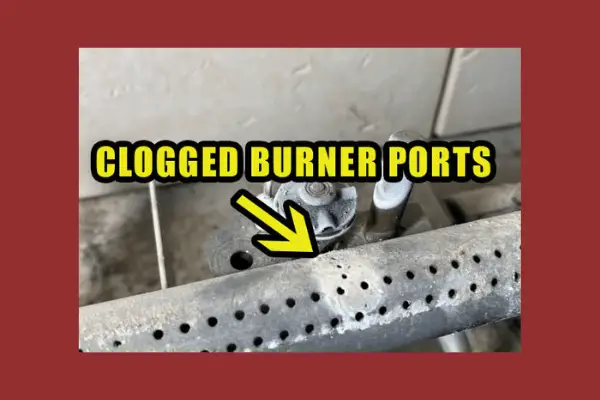
The build-up of carbon deposits inside them doesn’t allow gas to properly pass through them. Because of that, they can’t produce a large enough flame for the fireplace to stay lit and keeps shutting off.
Solution:
The solution here, as you’ve already guessed, is to clean the burner ports. You can always hire an expert fireplace technician to do this job if you don’t feel comfortable doing it yourself.
7. Cracked Components
One common potential cause behind gas fireplace constantly shutting off that is often overlooked by people is the cracking or breaking of certain components in the fireplace.
If you find broken pieces, holes, or cracks in certain places of the fireplace when you clean it, you need to address the issue ASAP. It can not only lead to major expensive repairs but also cause injury to you.
Solution:
If you detect cracked or broken components in your fireplace, call in a technician to have it fixed. Cracks in certain places can cause the gas to leak from your fireplace and start a fire.
If left unchecked, it can cause bring serious harm to the people living in your house and this isn’t something you should take lightly. Get these components fixed or replaced to make sure your fireplace stays lit and prevent any accidents from happening.
Other Reasons Why Your Gas Fireplace Won’t Stay Lit
These issues have been placed in another section because they’re not as common as the ones mentioned above. The issues placed here are either extremely easy to fix or you won’t be able to DIY it and you’ll have to seek professional help. Here they are:
i). Faulty Gas Valve
It’s not common for gas valves to go bad but just like other components, they can malfunction; especially, if they’ve been used for a lifetime. You’ll find the gas valve in the firebox.
Before calling in a technician, make sure it’s in the “On” position. If you don’t get a proper supply of gas despite the gas valve being in the current position, it has most likely gone bad.
If the gas valve is in a parallel position and looks straight, that means it’s turned on. But if it’s bent at 90 degrees, that means it’s switched off.
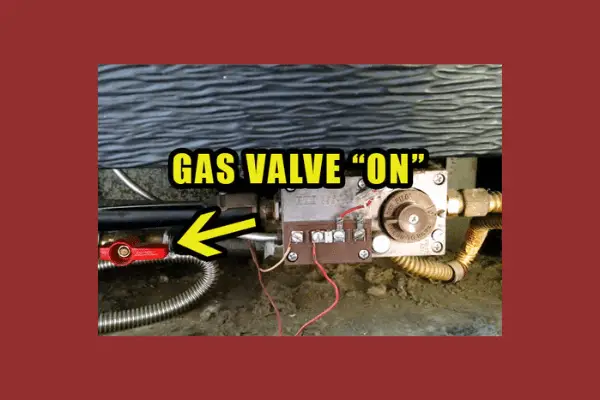
A faulty gas valve could be the reason why your gas fireplace shuts off after a few seconds when you turn it on. If it’s not opening as it should, have a technician check it out and replace the bad gas valve.
ii). Moisture In Gas Line
Another common issue caused by the gas line is the build-up of moisture in it. Moisture can cause a failure in the drip loop and if there’s moisture or water in the gas line, your gas fireplace won’t stay lit. You’d have to call in a technician to diagnose this issue as well as fix it.
iii). Dead Batteries
If you can control your fireplace with remote control, the batteries could be out of charge and cause this issue. Replace the batteries quickly to fix the problem or at least rule out dead batteries in your diagnosis.
iv). Tripped Circuit Breaker
The circuit breaker acts as a safety mechanism that gets tripped when there’s a larger flow of current than expected. It gets tripped to protect the circuit board from getting damaged. Inspect the circuit breaker and put it back to its original position if it has tripped.
What Are The Safety Measures When Cleaning A Gas Fireplace?
Most of the fixes that have been discussed to get your fireplace to run properly require cleaning certain components. While it’s safer to hire a technician for this purpose, many people would want to tackle the problem themselves.
If you decided to clean your gas fireplace yourself, keep in mind that you can’t play with fire and you need to proceed with caution. Here are some safety tips you should always follow when you’re working on a fireplace:
i). Turn Off The Gas Supply
If you keep the gas supply on when you clean your fireplace, you run the risk of the gas leaking into the environment. And then, disaster awaits. You’d also have no way to identify the leak before it gets too late.
Make sure the pilot light is fully out before you open up the different components to clean them. When the pilot light is completely out, you can be sure that all the supplied gas is burnt out. Then, you can clean your fireplace.
ii). Be Gentle When You Take Things Apart
It’s important to keep your cool when you’re taking the different components in your fireplace apart so that you can clean them. It can be hard to make some parts come out. Be patient when that happens and check twice whether the part is actually supposed to come apart.
The whole point of you doing the repair yourself is that it would cost less than hiring a mechanic. But if you break something because of getting angry or impatient, it could easily cost you much more to replace that.
iii). Avoid Spray Cleaners
Spray cleaners may seem like a good solution as they’re guaranteed to take care of the dust. But the issue with them is that most spray cleaners have a certain percentage of alcohol in them.
Even if you spray water and it gets into the gas lines, it can cause an explosion or lead to a large explosion. The outcome will be much worse with alcohol-based sprays.
So, go for the safer route here and use a simple dry brush to clean the dirt from the components in your fireplace.
How To Check Whether Your Fireplace Is Safe
It’s not a good place to be in if you’re unsure about whether your fireplace is safe or not. So, it’s better to be completely sure about the safety of your fireplace.
The compilation of dirt, excessive heat, and water can keep the fireplace from functioning properly and that can confuse you. Here are a few ways you can choose to determine whether its safe or not:
i). Inspect The Cleanliness Of The Components
The biggest issue when it comes to fireplaces is the clogging of components. When dirt and debris pile up, they block the path for fire and gas.
If the connection between the fuel tank and the burner is clogged, it can cause problems and you should consult a technician to take a look.
ii). Check The Quality Of Flame
The condition of the flame tells a lot about the state of the fireplace. If the flame is completely blue or completely yellow, there’s something wrong with your fireplace. Ideally, the flame should be mostly blue with a little yellow.
It should light up instantly and be free from any odor. It’s a bad sign if you light up the fireplace and the flame doesn’t light up instantly or gives an unstable flame.
iii). Investigate The Chimney
The chimney is without a doubt the most important component of your fireplace. Observe the chimney from the outside to make sure that it’s ready for use.
Use a binocular or climb up a ladder and get close to the chimney to confirm if the chimney cap is closed.
The chimney being closed is essential as it keeps rain, animal, snow, twigs, and branches from entering the chimney. Hire a technician to fix your chimney if it’s blocked because of any reason.
FAQs:
Why is my gas fireplace going on and off?
The most common reasons behind a gas fireplace going on and off are a bad thermocouple, faulty thermopile, and insufficient gas pressure.
How to maintain your gas fireplace?
As you have seen, most of the issues caused in a gas fireplace are because of the build-up of dirt and parts becoming clogged. Clean it at regular intervals to prevent these issues from happening.
How to tell if you have a weak thermocouple?
When you do the multimeter test on your thermocouple and see that the reading is between 20-25 millivolts, it means that you have a weak thermocouple.
When should you replace the gas fireplace logs?
Gas logs are generally fireproof and last for a long time. But if you use your fireplace often, it’s a good idea to replace them every three to five years.
How long does a gas fireplace last?
Gas fireplaces don’t have a specific timeline for how long they can last. But if you take good care of them, they can easily last a few decades.
What should you do if the fireplace smells like gas?
If your fireplace smells like gas, it’s likely that you have a gas leakage. Turn off the fireplace immediately and open up the windows to make sure that the gas goes away.
Is it safe to keep a gas fireplace running all the time?
Given that gas fireplaces build up carbon monoxide in the air, you need proper ventilation to run it. It’s recommended that you don’t run the fireplace for more than two to three hours at a stretch.
What does it cost to fix a gas fireplace?
If you still can’t get your fireplace to work despite the fixes mentioned in this article, you have no choice but to call a technician. It can cost you between $100 to $300 depending on the difficulty of the job.
Conclusion
Gas fireplaces are great as they keep your house warm during the winter months. But it’s annoying if the gas fireplace shuts off after a few minutes when you turn them on.
More often than not, it’s either the pilot assembly or the thermocouple that causes the issue.
But if that’s not it, we hope you’ll find the reason that’s causing the issue with your gas fireplace and fix it after completing this article. Drop a comment if you have any more questions about gas fireplaces.
